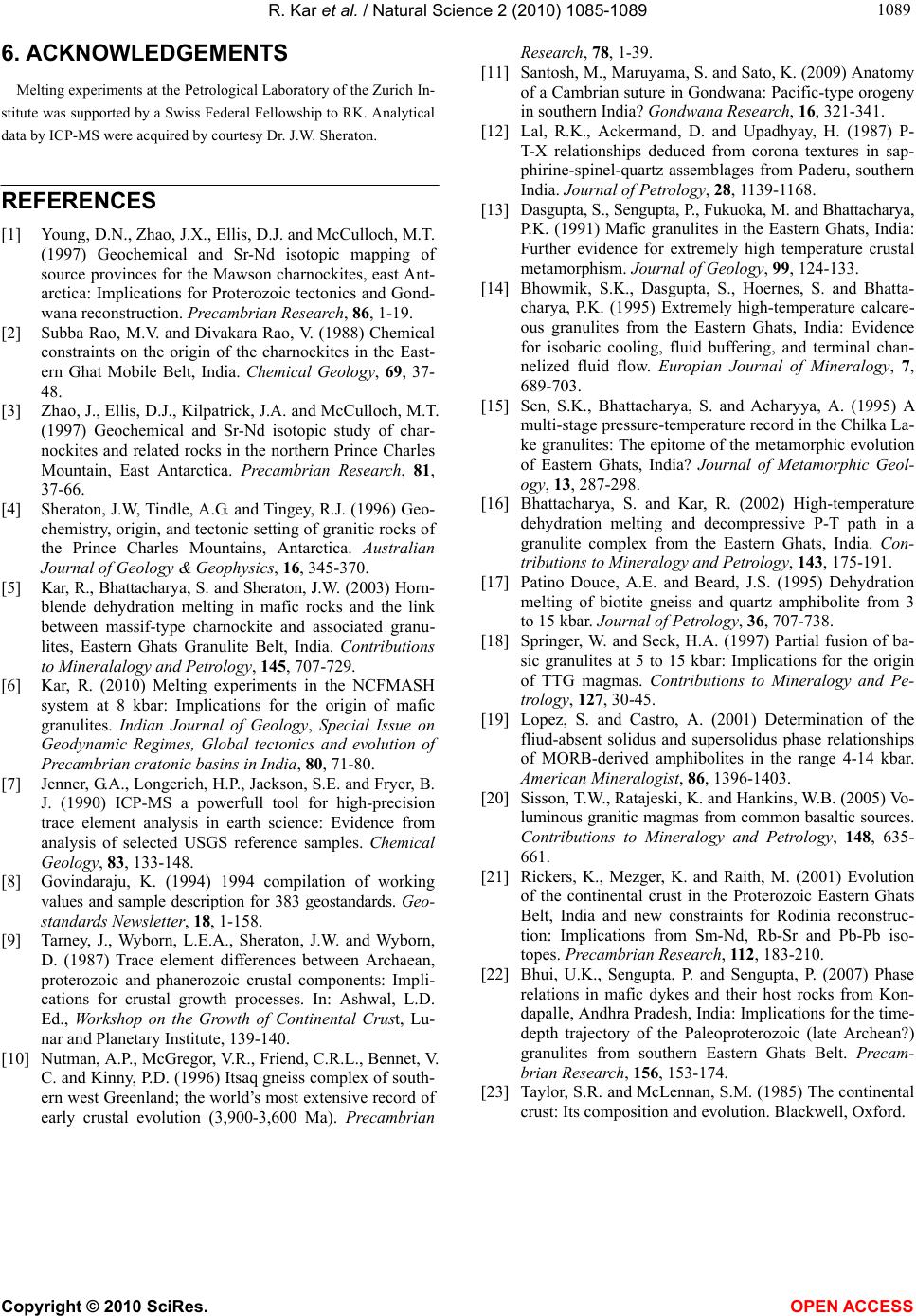
R. Kar et al. / Natural Science 2 (2010) 1085-1089
Copyright © 2010 SciRes. OPEN ACCESS
108
1089
6. ACKNOWLEDGEMENTS
Melting experiments at the Petrological Laboratory of the Zurich In-
stitute was supported by a Swiss Federal Fellowship to RK. Analytical
data by ICP-MS were acquired by courtesy Dr. J.W. Sheraton.
REFERENCES
[1] Young, D.N., Zhao, J.X., Ellis, D.J. and McCulloch, M.T.
(1997) Geochemical and Sr-Nd isotopic mapping of
source provinces for the Mawson charnockites, east Ant-
arctica: Implications for Proterozoic tectonics and Gond-
wana reconstruction. Precambrian Research, 86, 1-19.
[2] Subba Rao, M.V. and Divakara Rao, V. (1988) Chemical
constraints on the origin of the charnockites in the East-
ern Ghat Mobile Belt, India. Chemical Geology, 69, 37-
48.
[3] Zhao, J., Ellis, D.J., Kilpatrick, J.A. and McCulloch, M.T.
(1997) Geochemical and Sr-Nd isotopic study of char-
nockites and related rocks in the northern Prince Charles
Mountain, East Antarctica. Precambrian Research, 81,
37-66.
[4] Sheraton, J.W, Tindle, A.G. and Tingey, R.J. (1996) Geo-
chemistry, origin, and tectonic setting of granitic rocks of
the Prince Charles Mountains, Antarctica. Australian
Journal of Geology & Geophysics, 16, 345-370.
[5] Kar, R., Bhattacharya, S. and Sheraton, J.W. (2003) Horn-
blende dehydration melting in mafic rocks and the link
between massif-type charnockite and associated granu-
lites, Eastern Ghats Granulite Belt, India. Contributions
to Mineralalogy and Petrology, 145 , 707-729.
[6] Kar, R. (2010) Melting experiments in the NCFMASH
system at 8 kbar: Implications for the origin of mafic
granulites. Indian Journal of Geology, Special Issue on
Geodynamic Regimes, Global tectonics and evolution of
Precambrian cratonic basins in India, 80, 71-80.
[7] Jenner, G.A., Longerich, H.P., Jackson, S.E. and Fryer, B.
J. (1990) ICP-MS a powerfull tool for high-precision
trace element analysis in earth science: Evidence from
analysis of selected USGS reference samples. Chemical
Geology, 83, 133-148.
[8] Govindaraju, K. (1994) 1994 compilation of working
values and sample description for 383 geostandards. Geo-
standards Newsletter, 18, 1-158.
[9] Tarney, J., Wyborn, L.E.A., Sheraton, J.W. and Wyborn,
D. (1987) Trace element differences between Archaean,
proterozoic and phanerozoic crustal components: Impli-
cations for crustal growth processes. In: Ashwal, L.D.
Ed., Workshop on the Growth of Continental Crust, Lu-
nar and Planetary Institute, 139-140.
[10] Nutman, A.P., McGregor, V.R., Friend, C.R.L., Bennet, V.
C. and Kinny, P.D. (1996) Itsaq gneiss complex of south-
ern west Greenland; the world’s most extensive record of
early crustal evolution (3,900-3,600 Ma). Precambrian
Research, 78, 1-39.
[11] Santosh, M., Maruyama, S. and Sato, K. (2009) Anatomy
of a Cambrian suture in Gondwana: Pacific-type orogeny
in southern India? Gondwana Research, 16, 321-341.
[12] Lal, R.K., Ackermand, D. and Upadhyay, H. (1987) P-
T-X relationships deduced from corona textures in sap-
phirine-spinel-quartz assemblages from Paderu, southern
India. Journal of Petrology, 28, 1139-1168.
[13] Dasgupta, S., Sengupta, P., Fukuoka, M. and Bhattacharya,
P.K. (1991) Mafic granulites in the Eastern Ghats, India:
Further evidence for extremely high temperature crustal
metamorphism. Journal of Geology, 99, 124-133.
[14] Bhowmik, S.K., Dasgupta, S., Hoernes, S. and Bhatta-
charya, P.K. (1995) Extremely high-temperature calcare-
ous granulites from the Eastern Ghats, India: Evidence
for isobaric cooling, fluid buffering, and terminal chan-
nelized fluid flow. Europian Journal of Mineralogy, 7,
689-703.
[15] Sen, S.K., Bhattacharya, S. and Acharyya, A. (1995) A
multi-stage pressure-temperature record in the Chilka La-
ke granulites: The epitome of the metamorphic evolution
of Eastern Ghats, India? Journal of Metamorphic Geol-
ogy, 13, 287-298.
[16] Bhattacharya, S. and Kar, R. (2002) High-temperature
dehydration melting and decompressive P-T path in a
granulite complex from the Eastern Ghats, India. Con-
tributions to Mineralogy and Petrology, 143, 175-191.
[17] Patino Douce, A.E. and Beard, J.S. (1995) Dehydration
melting of biotite gneiss and quartz amphibolite from 3
to 15 kbar. Journal of Petrology, 36, 707-738.
[18] Springer, W. and Seck, H.A. (1997) Partial fusion of ba-
sic granulites at 5 to 15 kbar: Implications for the origin
of TTG magmas. Contributions to Mineralogy and Pe-
trology, 127, 30-45.
[19] Lopez, S. and Castro, A. (2001) Determination of the
fliud-absent solidus and supersolidus phase relationships
of MORB-derived amphibolites in the range 4-14 kbar.
American Mineralogist, 86, 1396-1403.
[20] Sisson, T.W., Ratajeski, K. and Hankins, W.B. (2005) Vo-
luminous granitic magmas from common basaltic sources.
Contributions to Mineralogy and Petrology, 148, 635-
661.
[21] Rickers, K., Mezger, K. and Raith, M. (2001) Evolution
of the continental crust in the Proterozoic Eastern Ghats
Belt, India and new constraints for Rodinia reconstruc-
tion: Implications from Sm-Nd, Rb-Sr and Pb-Pb iso-
topes. Precambrian Research, 112, 183-210.
[22] Bhui, U.K., Sengupta, P. and Sengupta, P. (2007) Phase
relations in mafic dykes and their host rocks from Kon-
dapalle, Andhra Pradesh, India: Implications for the time-
depth trajectory of the Paleoproterozoic (late Archean?)
granulites from southern Eastern Ghats Belt. Precam-
brian Research, 156, 153-174.
[23] Taylor, S.R. and McLennan, S.M. (1985) The continental
crust: Its composition and evolution. Blackwell, Oxford.